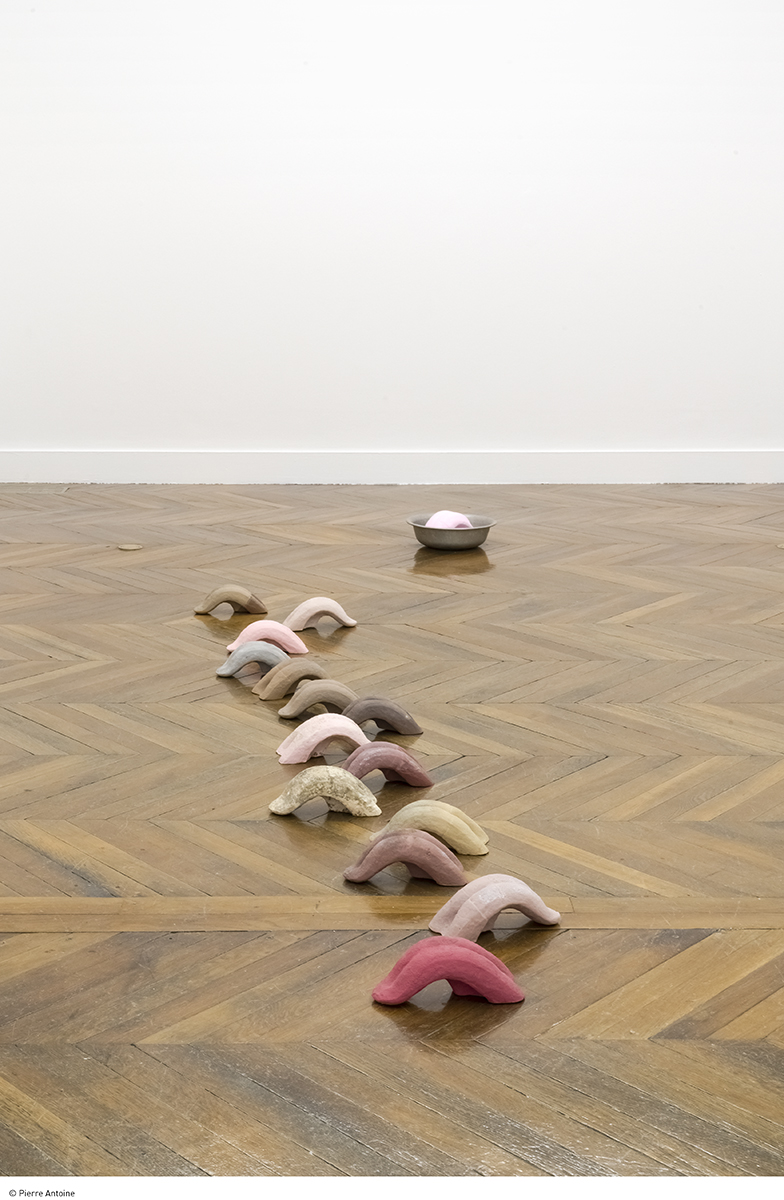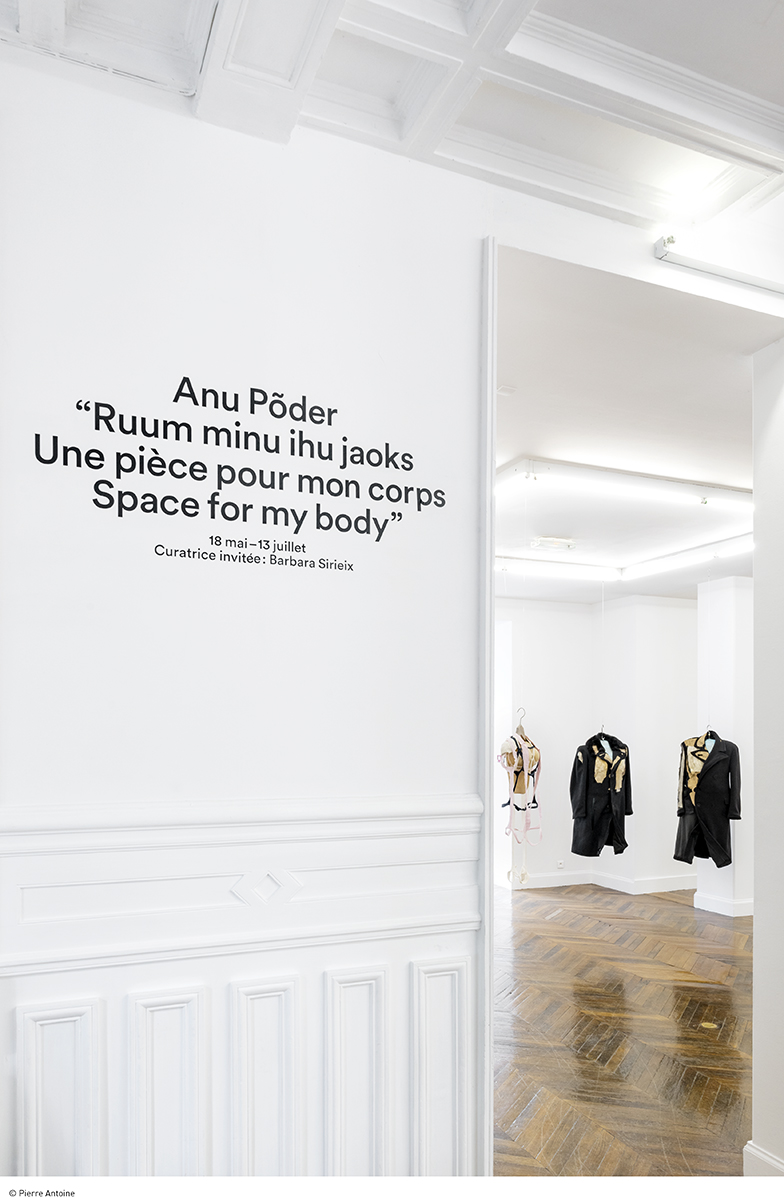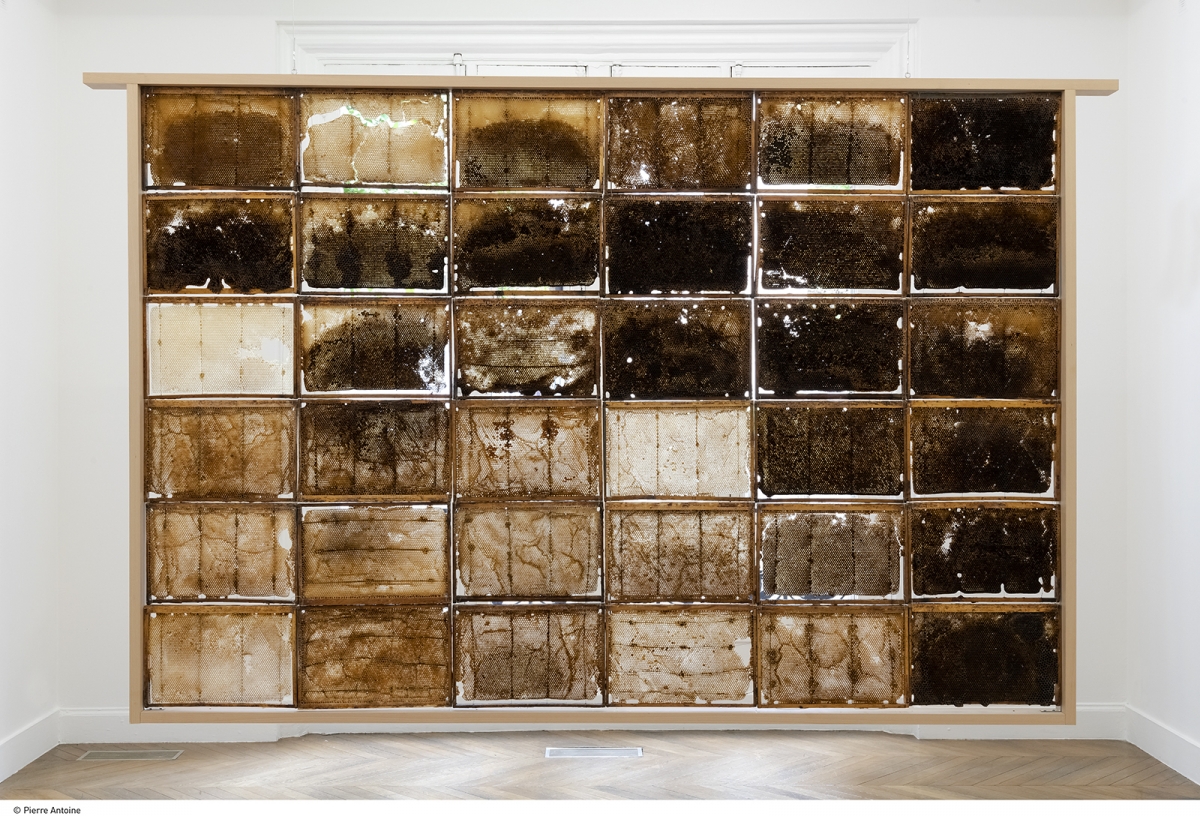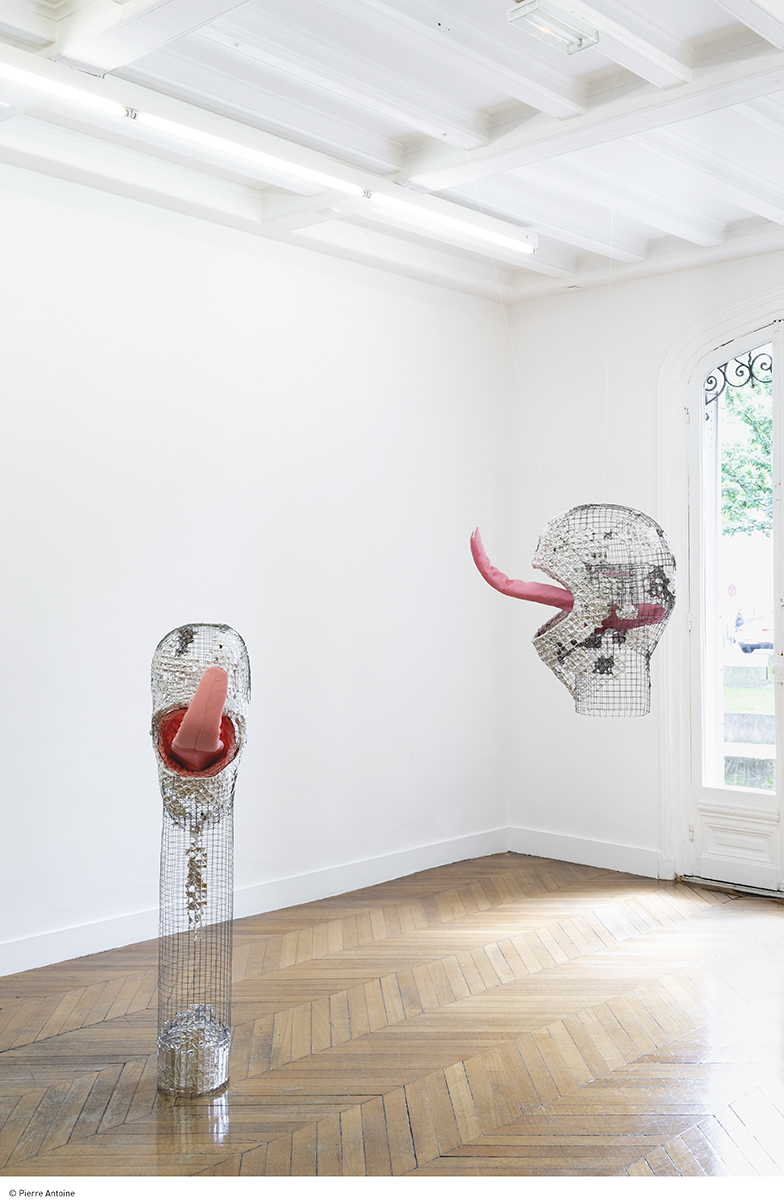The exhibition Ruum minu ihu jaoks / Une pièce pour mon corps / Space for my body, curated by Barbara Sirieix at La Galerie centre d’art contemporain, presented works by the Estonian sculptor and installation artist Anu Põder (1947–2013). Põder’s career began in the 1970s during the Soviet era and expanded into the 2000s – covering a period when Estonia was witnessing many faces of various political, social and economic systems which shaped the country’s identity and continues to do so even today. Põder’s practice has only recently been rediscovered[1] by curators and art historians who have primarily analysed her works according to feminist and post-colonial theories, enabling the artist’s fragile pieces mostly from her unique perspective on the body and its structural constraints to be interpreted through these lenses. Barbara Sirieix has been interested in the last period of Põder’s work between 1992 and 2008, when the artist renewed her aesthetic language and changed her representation of the body.[2] Accordingly, the exhibition at La Galerie centre d’art contemporain in Paris activated Põder’s fascinating sculptural works, serving as her first retrospective exhibition in France.
It was impossible not to notice the ardent environment where the exhibition took place. After a short train trip from the centre of Paris, one arrived in the municipality of Noisy-le-Sec, also known as part of the East United urban community. In the context of the exhibition, the area refers to the geopolitical background of the artist coming from a similar post-war environment – the former Soviet bloc. Amidst chaotic standardised unit housings lies La Galerie, an outstanding brick building (built in 1880) which was one of the few to survive the bombings of World War II. During the First World War, La Galerie’s building served both as a site to house the local military and an official evacuation hospital. Since 1999, the building has functioned as a contemporary art gallery.
The story of Põder’s sculptural pieces Katsetatud kasu. Kummist kotid / Tested Profit. Rubber Bags (1999) began with a similar environment to where they were being exhibited in, namely, an old hospital building in Tallinn where the artist carefully collected leftover rubber bags. The distorted bodies these works carry within them can’t be left unnoticed: their human-sized cut-outs marked deeply in the loose rubber bags stand silently on the wall. On the floor in front of these sculptural works lay Keeled / Tongues (1998) a colourful and captivating installation of animal tongues composed of home-made soaps that the artist’s mother had prepared in their countryside home in the south of Estonia during the Soviet era. The viewer is not only made to feel intimidated by the forms of these corporeal sculptures but also by the activation of a specific – not necessarily pleasant – odour, generated by a pinkish tongue left soaking in an aluminium bowl.
Põder tried to overpower the materials she chose to work with – soap, carbon, plastic, textile, chocolate, wood and wax – creating a mixture of the synthetic and natural materials that eventually come together as a delicate whole. The wall pieces Import- ja eksportkotid / Import and Export Bags (2001), made out of plastic bags for shipping goods, serve like stuffed pockets carrying sand and stones. The frail sculptural pieces bear up in spite of the sharpness and massiveness of heavy sand and small stones, remaining altogether unbreakable. Similarly, the installation Kärg / Honeycomb, (2007) comprising of naturally-woven beeswax structures, creates a certain perplexing moment of miniature patterns coming together as an immense sculptural wall. From up close, one could smell the sweet odour of beeswax silently filling the gallery space.
The purposes of Põder’s fragmented sculptural works are clearly to evoke memories and desire. Her head-shaped pieces Limpsijad / Lickers (2007), comprised of wired surfaces layered with aluminium, act appealing and disturbing at the same time. Their smooth pinkish tongues with shiny aluminium stripes on top reach out towards the viewer in a provocative manner of intense desire. Next to them, the metal installation Vahesein / Screen (2007) hides Kinder Surprise chocolate eggs – once the dream-come-true gift for children in the 1990s in Estonia after the country gained access to more consumer goods. It is not only the chocolate that the Lickers eventually come to point at but rather the complex labyrinth of memories and desires that linger between the past and the present.
Tricking the viewer by coinciding traces of time(s) and place(s) is inherent to Põder’s sculptural bodies. Patched clothes, layers of piled and glued fabrics act as overlapping memories unconsciously sewed together. Installation Lõige kui märk. Mantlid / Pattern as Sign. Fur Coats (1996) is made up of heavy puffer jackets, gathered by the artist from her relatives’ countryside homes, carrying a sense of belonging and nostalgia towards her loved ones. As much as they talk about emotional closeness and caring, they also touch on the subject of poverty and the lack of material possibilities – both inherent during the Soviet era and in the period of 1990s post-communist environment. Similarly, although gracefully still in their soft manner, sculptures Rulli keeratud figuur / Rolled-up Figure (1992) and Ruum minu ihu jaoks / Space for My Body (1995) feel almost trapped within themselves, lacking the courageous freedom of sexuality and noticed ambitions.

Exhibition view, Space for my body, Anu Põder, La Galerie, centre d’art contemporain de Noisy-le-Sec, Paris, 2019. Photo: Pierre Antoine
Throughout the exhibition the metaphor of the tongue – a form that is recurrent in Põder’s works – remains central. Either a joyful play of sexual appeal or stuck out tongues in defiance of the world, it embodies a way to oppose to the games of a dictatorial society. Fragile momentary materials become tools to cover well-hidden bodily expressions, almost as means of protecting oneself from the uncertainty of the outside world.
The domestic and emotional politics that are dominant in Põder’s practice continue to be topical today within the context of current political debates. With far-right-wing parties recently gaining more power in governments, the rights of women and the body as a political tool are being discussed on a daily basis. The rise of nationalism and the promotion of family values have been essential to small countries like Estonia where the demography has been in decline over the years, putting pressure on women to procreate.[3] Amongst other countries, Estonia also faces one of the highest gender pay gaps, which has continued to stay around 25%. Paradoxically, the Estonian language that does not have grammatical gender keeps the myth of a post-gendered society silently alive.
This might also explain the activation of Põder’s works and her resurgence in the contemporary art world, whose popularity has grown amongst generations who may only have vague memories (if any memories at all) of the Soviet period, and rather nostalgic feelings towards the 1990s and early 2000s, who can clearly relate to her practice from a contemporary angle. Her compelling sculptural pieces continue to resonate with the political debates over women rights, challenging societal changes and the complex fetishism of post-communist lifestyle. As such, the importance of the exhibition Space for my body lies in analysing Põder’s works critically within larger audiences who mostly confront them for the first time. Similarly to the French platform AWARE: Archives of Women Artists, Research and Exhibitions, the retrospective Space for my body does not just actualise the heritage and name of Anu Põder, but many of her contemporaries too, with the goal of restoring and creating greater presence for under-represented female artists, who have been excluded from the prevailing Western art-historical narratives.
In a rather stubborn way, Anu Põder’s practice stays in the same state of in-betweenness today as it did during her lifetime. She did not belong to the stagnant Soviet system, neither did she go along with the bubbling period of the 1990s, nor did she accept the feminist framing of her work later in her career – Põder kept her distance from the prevailing trends. Over the course of time, her strength has been proven to lie within her ability to make apparent the fine lines of belonging between the various histories of political and social disruptions, leaving space for healing and contemplation. Her subtle, ephemeral installations bring out the scarcity and fragility of one’s hopes and desires, while embodying the connecting force of distant times and places.
[1] The most comprehensive retrospective of the artist’s works has been the exhibition Anu Põder. Be Fragile! Be Brave! curated by Rebeka Põldsam in Kumu Contemporary Art Museum,Tallinn in 2017.
In 2018 installation Tongues (1998; 2018) was shown in Contemporary Art Centre, Vilnius in the framework of the Baltic Triennial exhibition Give Up The Ghost, artistic director Vincent Honoré.
Installations Rolled up Figure (1992) and Import and Export Bags (2001) were included to the group exhibition Chthonic Rift in Kraupa-Tuskany Zeidler, Berlin in 2018.
[2] Bembekoff Marc; Renard Émilie. Anu Põder, Not Dead. – Booklet of Ruum minu ihu jaoks / Une pièce pour mon corps / Space for my body, La Galerie centre d’art contemporain Noisy-le-Sec, 2019.
[3] There is a paid maternity leave of up to 18 months in Estonia. Although maternity leave is widely taken by women and has seen a positive increase in Estonia’s fertility rate in recent years, it has also created a rise in different forms of discrimination, such as loss of work and leadership roles for women.


Exhibition view, Space for my body, Anu Põder, La Galerie, centre d’art contemporain de Noisy-le-Sec, Paris, 2019. Photo: Pierre Antoine

Exhibition view, Space for my body, Anu Põder, La Galerie, centre d’art contemporain de Noisy-le-Sec, Paris, 2019. Photo: Pierre Antoine

Exhibition view, Space for my body, Anu Põder, La Galerie, centre d’art contemporain de Noisy-le-Sec, Paris, 2019. Photo: Pierre Antoine

Exhibition view, Space for my body, Anu Põder, La Galerie, centre d’art contemporain de Noisy-le-Sec, Paris, 2019. Photo: Pierre Antoine

Exhibition view, Space for my body, Anu Põder, La Galerie, centre d’art contemporain de Noisy-le-Sec, Paris, 2019. Photo: Pierre Antoine

Exhibition view, Space for my body, Anu Põder, La Galerie, centre d’art contemporain de Noisy-le-Sec, Paris, 2019. Photo: Pierre Antoine

Exhibition view, Space for my body, Anu Põder, La Galerie, centre d’art contemporain de Noisy-le-Sec, Paris, 2019. Photo: Pierre Antoine






























